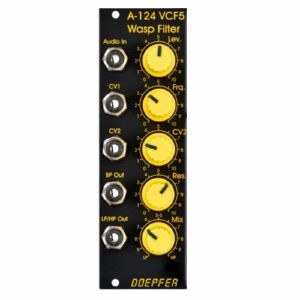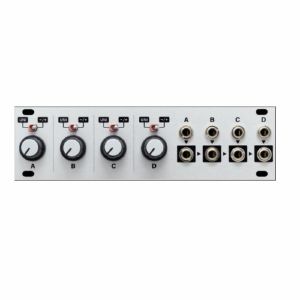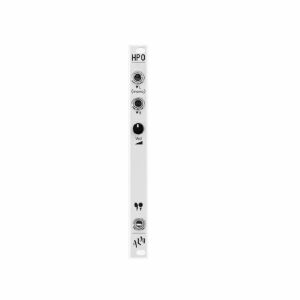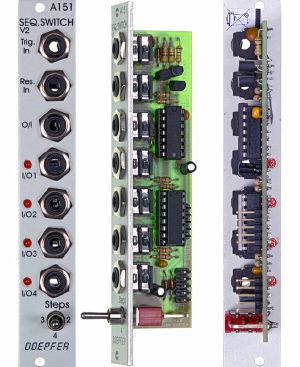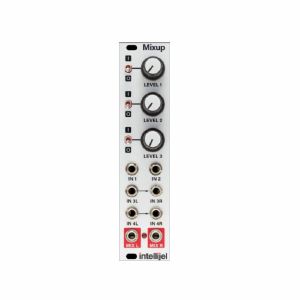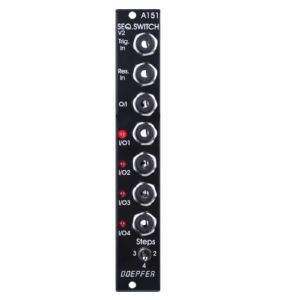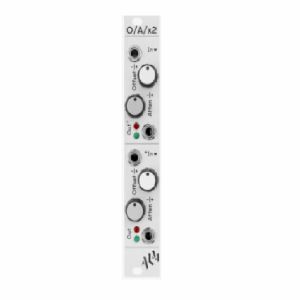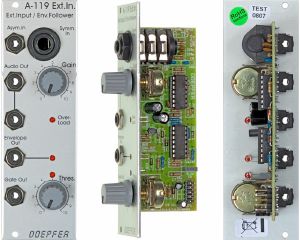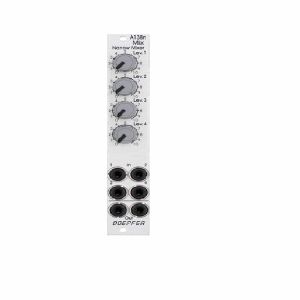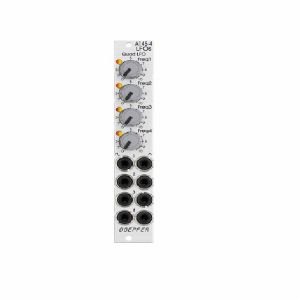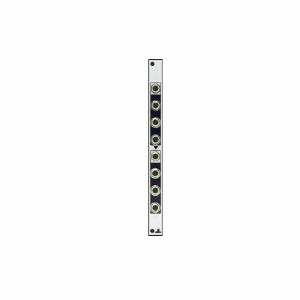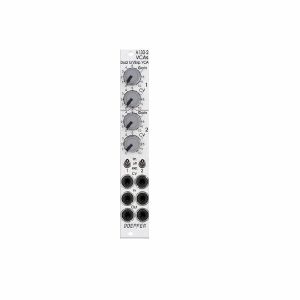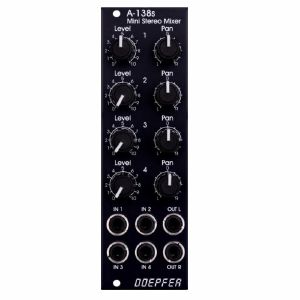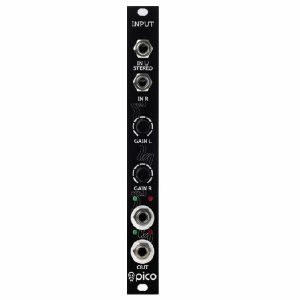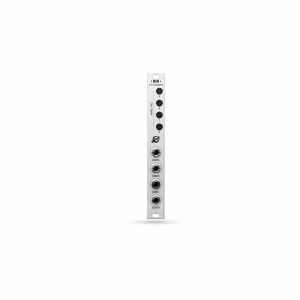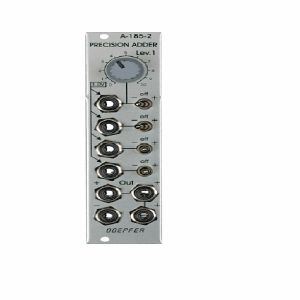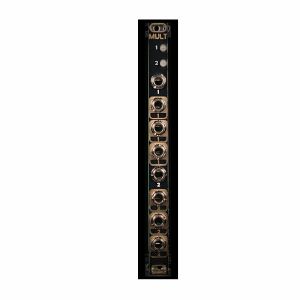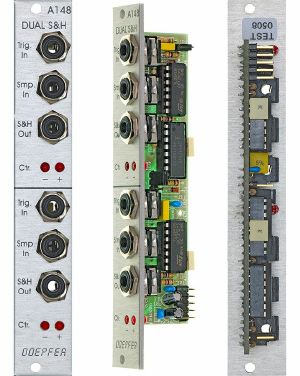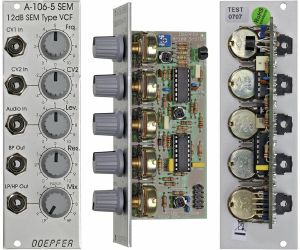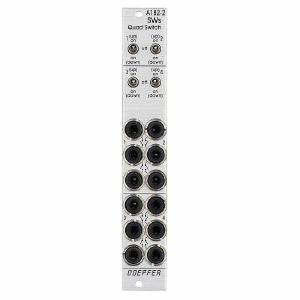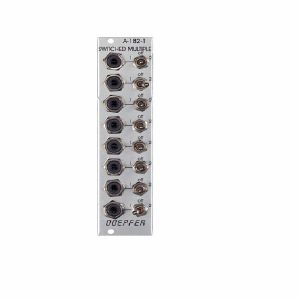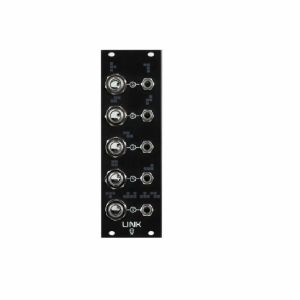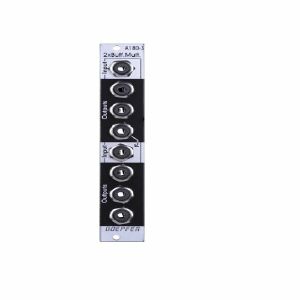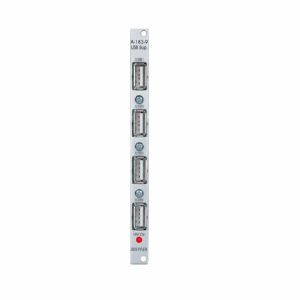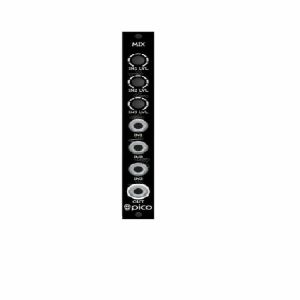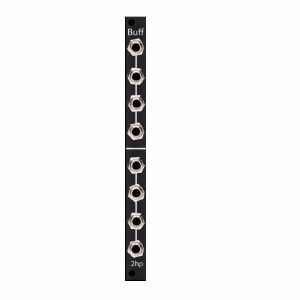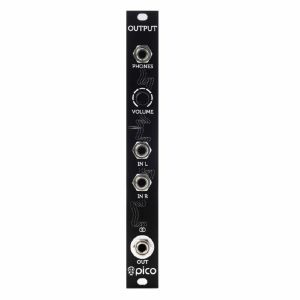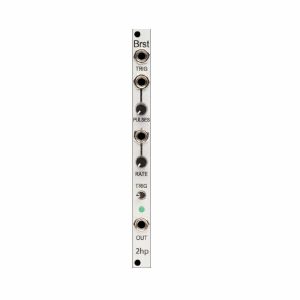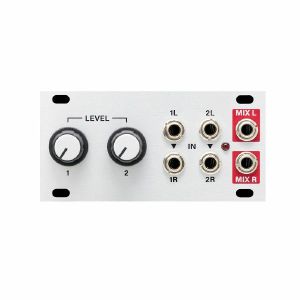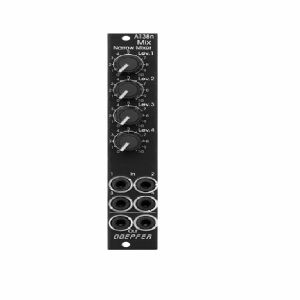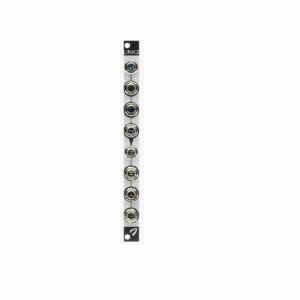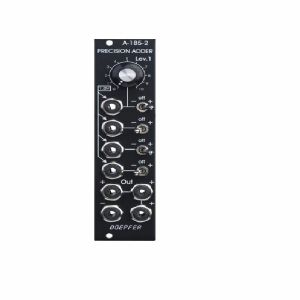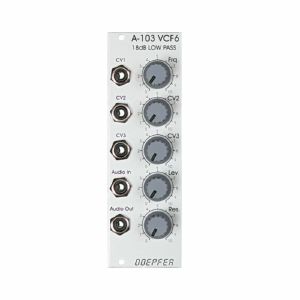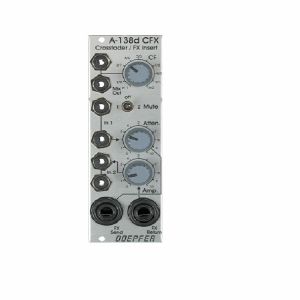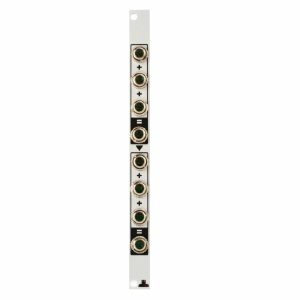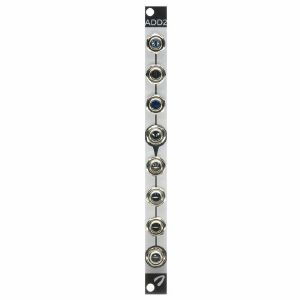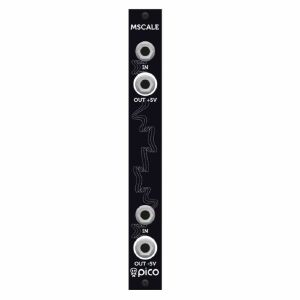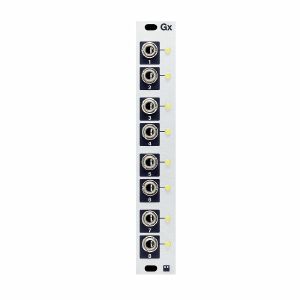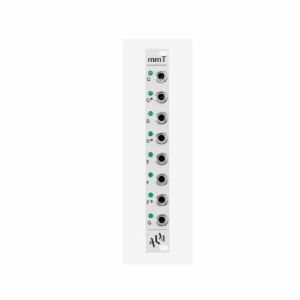All genres charts
Bestselling All genres vinylDoepfer A-124 VCF5 Wasp Filter 12dB Multimode Filter Module (special edition, black/yellow) (filter synth module)
Cat: 671564 Rel: 29 Nov 17
12dB multi-mode filter with unique classic circuitry, based on the filter from the 70s EDP Wasp synth
Notes: Module A-124 is a special 12dB multimode filter using the "strange" filter circuit of the "EDP Wasp" (an analog synthesizer with black/yellow case built end of the seventies, manufactured by the UK company "Electronic Dream Plant" with Chris Huggett und Adrian Wagner). This design "abuses" digital inverters as analog operational amplifiers leading to distortions and other "dirty" effects that generate the specific sound of this filter. The filter is equipped with a band pass output and a combined low/notch/high pass output. For this output a control knob defines the relation between low and high pass signal. If both signals appear at the same level (i.e. middle position of the Mix knob) one obtains a notch filter. Otherwise the low or high pass signal predominates. The module does not feature self-oscillation in contrast to most of the other filters of the A-100 system.
Inputs: Audio In, CV In (2x)
Outputs: Bandpass Out, Low/Highpass Mix-Out
Controls: Audio and CV attenuator, Frequency, Resonance, LP/HP Mix
The function and operation of this module is very similar to the module SEM VCF A-106-5. But the sound of both filters is very different! The only functional difference is the position of the sockets and controls, and the function of the controls CV2 (A-124: normal attenuator, A-106-5: polarizer).
- 3U Eurorack module, 8HP wide, 45mm deep
- Current draw 30mA
… Read moreInputs: Audio In, CV In (2x)
Outputs: Bandpass Out, Low/Highpass Mix-Out
Controls: Audio and CV attenuator, Frequency, Resonance, LP/HP Mix
The function and operation of this module is very similar to the module SEM VCF A-106-5. But the sound of both filters is very different! The only functional difference is the position of the sockets and controls, and the function of the controls CV2 (A-124: normal attenuator, A-106-5: polarizer).
- 3U Eurorack module, 8HP wide, 45mm deep
- Current draw 30mA
3 in stock $94.16
Click for better price!
or call +44 20 7424 1960
quote 671564
quote 671564
Intellijel Quadratt 1U Quad Attenuator Attenuverter Mixer & DC Voltage Source Module (attenuator/mixer/utility/CV modulation synth module)
Cat: 602205 Rel: 04 Apr 16
Quad attenuator, attenuverter, mixer and DC voltage source - 28HP wide
Notes: The shorter and wider brother to the popular Triatt module!
The four handy knobs can act as active attenuators (unipolar) or attenuverters (bipolar) depending on the setting of the two-position switches above each one.
Each input is normalled to a precision +5V DC voltage source. With nothing plugged into the jacks, each knob controls a voltage range of 0 to +5 v or -5 to +5 v depending on the position of the mode switch.
- 2 modes for each channel
- 5v normalled to each input
- With external signals it acts as active/buffered attenuator/attenuverter/mixer
- Each output normalled to mix into the adjacent channel on the right making it possible to do sub mixes in groups of 2, 3 or all four channels.
… Read moreThe four handy knobs can act as active attenuators (unipolar) or attenuverters (bipolar) depending on the setting of the two-position switches above each one.
Each input is normalled to a precision +5V DC voltage source. With nothing plugged into the jacks, each knob controls a voltage range of 0 to +5 v or -5 to +5 v depending on the position of the mode switch.
- 2 modes for each channel
- 5v normalled to each input
- With external signals it acts as active/buffered attenuator/attenuverter/mixer
- Each output normalled to mix into the adjacent channel on the right making it possible to do sub mixes in groups of 2, 3 or all four channels.
4 in stock $80.71
Click for better price!
or call +44 20 7424 1960
quote 602205
quote 602205
ALM HPO Stereo Headphone Output Module (external synth module)
Cat: 688779 Rel: 11 Jul 18
Stereo headphone driver output - 2HP
Notes: The 'HPO' is an affordable super slim and skiff friendly no frills stereo headphone driver output for your modular synthesiser. Includes a volume control and ability to double up a mono signal into stereo. A great use for that left over 2hp in a skiff or larger system.
Give loved ones, friends and acquaintances a break from your musical 'genius', the HPO offers a solitary cell for focused creativity impregnable from undeserving non-believers.
… Read moreGive loved ones, friends and acquaintances a break from your musical 'genius', the HPO offers a solitary cell for focused creativity impregnable from undeserving non-believers.
4 in stock $60.53
Doepfer A-151 Sequential Switch v2 Module (silver) (switch synth module)
Cat: 577792 Rel: 06 Jun 19
Quad sequential switch module - 4HP
Notes: Module A-151 (Quad Sequential Switch) is like an electronic four-position rotary switch.
It includes trigger and reset inputs, four in / outputs, and a common out / input. Each time a pulse is received at the trigger input socket, the common out / input is connected to the next in / output. After the fourth in / output, the next trigger makes it step back to the first again, and so on. A positive pulse at the reset input switches the out / input immediately back to the first in / output.
Voltages in the range -12V...+12V at the O/I resp. I/O sockets can be processed by the module (not only control voltages but also gate, trigger or clock signals provided that they are in the -12V...+12V range).
By means of a toggle switch the number of steps can be limited to 2, 3 or 4.
Four LEDs indicate the active in / output (ie. the on that is connected to the out / input at any particular time).
For more detailed information please look at the English user's manual: A151_man.pdf.
Similar modules:
A-150-1 Dual Voltage Controlled Switch
A-150-8 Octal Manual/Voltage Controlled Programmable Switches
A-152 Voltage Addressed Track&Hold / Switch (Multiplexer) / Digital Outputs
Technical notes:
To protect the electronic switches in case of an unsuitable patch (e.g. connection of two outputs) a 1k protection resistor is inserted into the O/I line. If control voltages used for VCOs are switched this may cause a small voltage drop and lead to undesired audible detuning. For this application we recommend to insert a CV buffer between A-151 and the VCO(s), e.g. the modules A-180-3, A-180-4 or the Precision Adder A-185-2. Integrating the buffer into the module A-151 is not possible because this would ruin the bidirectionality of the switches.
For modules manufactured before spring 2005 the voltage range at the in/outputs was limited to -8V...+8V. From spring 2005 the revised version of the module was available. With an additional switch the number of steps can be set to 2, 3 or 4 (thanks to Peter Grenader for this idea). Moreover the revised module allows to process voltages in the full A-100 voltage range (i.e. -12V...+12V). The limitation to -8V...+8V is no longer valid. The A-100 DIY page describes how to install this additional switch for the old version of A-151.
Width: 4 HP / 20.0 mm
Depth: 35 mm (measured from the rear side of the front panel)
Current: +20mA (+12V) / -10mA (-12V)
… Read moreIt includes trigger and reset inputs, four in / outputs, and a common out / input. Each time a pulse is received at the trigger input socket, the common out / input is connected to the next in / output. After the fourth in / output, the next trigger makes it step back to the first again, and so on. A positive pulse at the reset input switches the out / input immediately back to the first in / output.
Voltages in the range -12V...+12V at the O/I resp. I/O sockets can be processed by the module (not only control voltages but also gate, trigger or clock signals provided that they are in the -12V...+12V range).
By means of a toggle switch the number of steps can be limited to 2, 3 or 4.
Four LEDs indicate the active in / output (ie. the on that is connected to the out / input at any particular time).
For more detailed information please look at the English user's manual: A151_man.pdf.
Similar modules:
A-150-1 Dual Voltage Controlled Switch
A-150-8 Octal Manual/Voltage Controlled Programmable Switches
A-152 Voltage Addressed Track&Hold / Switch (Multiplexer) / Digital Outputs
Technical notes:
To protect the electronic switches in case of an unsuitable patch (e.g. connection of two outputs) a 1k protection resistor is inserted into the O/I line. If control voltages used for VCOs are switched this may cause a small voltage drop and lead to undesired audible detuning. For this application we recommend to insert a CV buffer between A-151 and the VCO(s), e.g. the modules A-180-3, A-180-4 or the Precision Adder A-185-2. Integrating the buffer into the module A-151 is not possible because this would ruin the bidirectionality of the switches.
For modules manufactured before spring 2005 the voltage range at the in/outputs was limited to -8V...+8V. From spring 2005 the revised version of the module was available. With an additional switch the number of steps can be set to 2, 3 or 4 (thanks to Peter Grenader for this idea). Moreover the revised module allows to process voltages in the full A-100 voltage range (i.e. -12V...+12V). The limitation to -8V...+8V is no longer valid. The A-100 DIY page describes how to install this additional switch for the old version of A-151.
Width: 4 HP / 20.0 mm
Depth: 35 mm (measured from the rear side of the front panel)
Current: +20mA (+12V) / -10mA (-12V)
1 in stock $62.78
Intellijel Mixup Chainable Mono & Stereo Audio Utility Mixer Module (mixer synth module)
Cat: 673868 Rel: 12 Jan 18
Versatile audio mixer module - 6HP
Notes: Mixup is a versatile, expandable audio mixer for Eurorack format. It has eight inputs (6 on the front panel) and two outputs. Inputs 1 and 2 are single-channel mono inputs, each with its own mute switch and level control; Input 3 is a dual-channel stereo input with a shared mute and level control; and input 4 is an auxiliary unity-gain, non-mutable stereo input.
Using bus connectors on the back panel, you can chain multiple Mixups together in series, giving you the ability to mix together even more inputs, or to create sub-mixes for routing around larger systems.
Because Mixup is designed specifically for audio (and not for CV mixing), it uses AC-coupled circuitry (which reduces the potential for 'pops' when muting and unmuting audio), and it uses audio-grade, logarithmic attenuators for a smooth, even response across the entire volume range.
… Read moreUsing bus connectors on the back panel, you can chain multiple Mixups together in series, giving you the ability to mix together even more inputs, or to create sub-mixes for routing around larger systems.
Because Mixup is designed specifically for audio (and not for CV mixing), it uses AC-coupled circuitry (which reduces the potential for 'pops' when muting and unmuting audio), and it uses audio-grade, logarithmic attenuators for a smooth, even response across the entire volume range.
2 in stock $96.41
Click for better price!
or call +44 20 7424 1960
quote 673868
quote 673868
Doepfer A-151v Quad Sequential Switch Vintage Edition Module (black) (CV processor synth module)
Cat: 684462 Rel: 22 May 18
Electronic switch with up to four steps - 4HP
Notes: Module A-151 (Quad Sequential Switch) is like an electronic four-position rotary switch.
It includes trigger and reset inputs, four in/outputs, and a common out/input. Each time a pulse is received at the trigger input socket, the common out/input is connected to the next in/output. After the fourth in/output, the next trigger makes it step back to the first again, and so on. A positive pulse at the reset input switches the out/input immediately back to the first in/output. Voltages in the range -8V...+8V at the O/I resp. I/O sockets can be processed by the module.
Four LED's indicate the active in/output (ie. the one that is connected to the out/input at any particular time).
… Read moreIt includes trigger and reset inputs, four in/outputs, and a common out/input. Each time a pulse is received at the trigger input socket, the common out/input is connected to the next in/output. After the fourth in/output, the next trigger makes it step back to the first again, and so on. A positive pulse at the reset input switches the out/input immediately back to the first in/output. Voltages in the range -8V...+8V at the O/I resp. I/O sockets can be processed by the module.
Four LED's indicate the active in/output (ie. the one that is connected to the out/input at any particular time).
1 in stock $68.39
ALM O/A/x2 Dual Channel Offset & Attenuverter Module (atenuator/dual/stereo/mixer/polarizer/utility synth module)
Cat: 584260 Rel: 15 Apr 16
Dual channel attenuverter synthesiser module - 4HP
Notes: 'O/A/x2' is a dual channel attenuverter with each channel also including a bipolar voltage offset and LED monitoring. The module is primarily intended for fine grain flexible 'editing' of control signals (i.e changing the phase, level and DC offset of an LFO signal) but also has uses with audio signals such as attenuation, inversion and mixing.
Technical Specifications:
Supply: +/-12V (Reverse voltage protection)
Current Draw: ~50ma
Size: 4 HP
Depth: 32mm (including power header)
… Read moreTechnical Specifications:
Supply: +/-12V (Reverse voltage protection)
Current Draw: ~50ma
Size: 4 HP
Depth: 32mm (including power header)
2 in stock $86.62
Click for better price!
or call +44 20 7424 1960
quote 584260
quote 584260
Doepfer A-119 External Input Envelope Follower Module (silver) (external/envelope follower/preamp/controller/comparator synth module)
Cat: 577771 Rel: 29 Nov 17
Envelope follower & pre-amplifier for microphone/line-signals - 8HP
Notes: Module A-119 (External Input / Envelope Follower) is designed to allow external audio signals to be integrated into the System A-100. It comprises a pre-amp, envelope follower, and comparator.
The pre-amp has two inputs: an unbalanced input for line level signals, with a gain factor of from 0 to 20, and a balanced input with a gain factor of from 0 to 500, for insertion of low level signals, for instance from a microphone or electric guitar.
The Envelope Follower reads the signal level of the input, and puts out a proportional voltage as an envelope at its own output.
The comparator generates a gate signal whenever the input goes above an adjustable trigger threshold.
Three LED's help you keep track of overload, the envelope, and the gate signal.
… Read moreThe pre-amp has two inputs: an unbalanced input for line level signals, with a gain factor of from 0 to 20, and a balanced input with a gain factor of from 0 to 500, for insertion of low level signals, for instance from a microphone or electric guitar.
The Envelope Follower reads the signal level of the input, and puts out a proportional voltage as an envelope at its own output.
The comparator generates a gate signal whenever the input goes above an adjustable trigger threshold.
Three LED's help you keep track of overload, the envelope, and the gate signal.
1 in stock $81.01
Click for better price!
or call +44 20 7424 1960
quote 577771
quote 577771
Doepfer A-138n Narrow Mixer Module (silver, slim line series) (mixer synth module)
Cat: 731947 Rel: 10 Jun 19
4-channel mixer module - 4HP
Notes: Module A-138n is a simple four channel mixer, which can be used with either control voltages or audio signals. Each of the four inputs has an attenuator available. The output is twice available (two sockets, hard-wired like a multiple).
The module is the slim version of module A-138a and offers nearly the same features. But the distances between the controls are smaller and rubberized small-sized knobs are used. In return the front panel has 4 HP only which is half the width of the A-138a. The module is primarily planned for applications where only limited space is available. The only functional difference compared to the A-138a is the missing attenuator for the (dual) output.
Width: 4HP / 20.0 mm
Depth: 30 mm (measured from the rear side of the front panel)
Current: +10mA (+12V) / -10mA (-12V)
… Read moreThe module is the slim version of module A-138a and offers nearly the same features. But the distances between the controls are smaller and rubberized small-sized knobs are used. In return the front panel has 4 HP only which is half the width of the A-138a. The module is primarily planned for applications where only limited space is available. The only functional difference compared to the A-138a is the missing attenuator for the (dual) output.
Width: 4HP / 20.0 mm
Depth: 30 mm (measured from the rear side of the front panel)
Current: +10mA (+12V) / -10mA (-12V)
2 in stock $62.22
ALM SBG Guitar Effects Pedals Interface Module (attenuator/external/utility/mixer synth module)
Cat: 584253 Rel: 15 Apr 16
Compact utility synthesiser module for interfacing guitar effects with eurorack modular system - 4HP wide
Notes: The 'S.B.G' is a compact utility module intended for the interfacing of guitar effect pedals with your eurorack modular system.
It provides both attenuation and amplification of audio signals for level matching together with a crossfade control to conveniently adjust the wet/dry mix of a processed signal. The module also offers regulation of outgoing CV signals for safer use of pedal expression inputs.
Technical Specifications:
Supply: +/-12V (Reverse voltage protection)
Current Draw: ~30ma
Size: 4 HP
Depth: 22mm (including power header)
… Read moreIt provides both attenuation and amplification of audio signals for level matching together with a crossfade control to conveniently adjust the wet/dry mix of a processed signal. The module also offers regulation of outgoing CV signals for safer use of pedal expression inputs.
Technical Specifications:
Supply: +/-12V (Reverse voltage protection)
Current Draw: ~30ma
Size: 4 HP
Depth: 22mm (including power header)
1 in stock $97.53
Doepfer A-145-4 LFOs Quad Low Frequency Oscillator Slim Line Module (silver) (LFO synth module)
Cat: 731949 Rel: 10 Jun 19
Quad low frequency oscillator - 4HP
Notes: Module A-145-4 is a simple quad LFO (Low Frequency Oscillator). Not a very "exciting" module, just a bread-and-butter device and a simple demon for work. Virtually in every modular system several LFOs are required for modulation purposes. The module contains four simple LFOs with the waveforms triangle and rectangle. A dual colour LED (red = positive / yellow = negative output voltage) indicates the triangle output of each LFO. The frequency range can be chosen for each LFO individually by means of a jumper between about 50 Hz ... 0.04 Hz (about 20 seconds, jumper removed) and about 2Hz ... 0.002 (about 8 minutes, jumper installed).
The module can be treated as a slimmed version of the quad LFO A-143-3 as it has similar features available. But the distances between the controls are smaller and rubberized small-sized knobs are used. In return the front panel has 4 HP only which is less than one third of the A-143-3. The module is primarily planned for applications where only limited space is available. The functional difference compared to the A-143-3 are the missing sawtooth outputs and frequency range switches.
… Read moreThe module can be treated as a slimmed version of the quad LFO A-143-3 as it has similar features available. But the distances between the controls are smaller and rubberized small-sized knobs are used. In return the front panel has 4 HP only which is less than one third of the A-143-3. The module is primarily planned for applications where only limited space is available. The functional difference compared to the A-143-3 are the missing sawtooth outputs and frequency range switches.
1 in stock $87.44
Click for better price!
or call +44 20 7424 1960
quote 731949
quote 731949
Intellijel Buff Mult Buffered Multiple Module (multiple module)
Cat: 563563 Rel: 10 Mar 15
Buffered multiple synth module, 2HP wide
Notes: Dual 1 x 3 buffered mult (one audio or cv signal in with multiple buffered outputs).
The output of the first mult is normalled to the input of the second mult to create a 1×6 buffered mult
… Read moreThe output of the first mult is normalled to the input of the second mult to create a 1×6 buffered mult
More than 10 in stock $70.62
Click for better price!
or call +44 20 7424 1960
quote 563563
quote 563563
Doepfer A-130-2 Dual Linear/Exponential VCA Slim Line Series Module (dual/stereo/VCA synth module)
Cat: 731940 Rel: 11 Jun 19
Compact two-channel VCA - 4HP
Notes: Module A-130-2 is the slim version of module A-132-3 and offers essentially the same features. But the distances between the controls are smaller and rubberized small-sized knobs are used. In return the front panel has 4 HP only which is half the width of the A-132-3. The module is primarily planned for applications where only limited space is available.
The module is composed of two identical voltage controlled amplifiers (VCA). Each VCA has a manual gain control (also named Initial Gain) and a control voltage input with attenuator. The character of the control scale can be switched to linear or exponential. All inputs and outputs are DC coupled. Consequently the VCAs can be used to process both audio and control voltages (e.g. for voltage control of the level of LFO or envelope signals). The signal input has no attenuator available but is capable to process up to 16Vpp signals (i.e. -8V...+8V) without distortion. For the processing of higher levels an external attenuator (e.g. A-183-1) is recommended.
The amplification range is 0...1. Even with a higher external control voltage the amplification remains at 1 (kind of "amplification clipping" at 1).
Controls (for each of both units):
- Gain: manual gain control (Initial Gain) in the range 0...1
- CV: attenuator for the CV input
- Lin/Exp: switches the VCA characteristic to linear or exponential, in center position the VCA is off (mute function)
Inputs and outputs (for each of both units):
- CV: control voltage input, min. +5V required for max. amplification (1) with CV control fully CW and Gain fully CCW
- In: signal input, max. 16Vpp (+8V...-8V) without distortion
- Out: signal output
… Read moreThe module is composed of two identical voltage controlled amplifiers (VCA). Each VCA has a manual gain control (also named Initial Gain) and a control voltage input with attenuator. The character of the control scale can be switched to linear or exponential. All inputs and outputs are DC coupled. Consequently the VCAs can be used to process both audio and control voltages (e.g. for voltage control of the level of LFO or envelope signals). The signal input has no attenuator available but is capable to process up to 16Vpp signals (i.e. -8V...+8V) without distortion. For the processing of higher levels an external attenuator (e.g. A-183-1) is recommended.
The amplification range is 0...1. Even with a higher external control voltage the amplification remains at 1 (kind of "amplification clipping" at 1).
Controls (for each of both units):
- Gain: manual gain control (Initial Gain) in the range 0...1
- CV: attenuator for the CV input
- Lin/Exp: switches the VCA characteristic to linear or exponential, in center position the VCA is off (mute function)
Inputs and outputs (for each of both units):
- CV: control voltage input, min. +5V required for max. amplification (1) with CV control fully CW and Gain fully CCW
- In: signal input, max. 16Vpp (+8V...-8V) without distortion
- Out: signal output
6 in stock $90.25
Click for better price!
or call +44 20 7424 1960
quote 731940
quote 731940
Meng Qi DPLPG Dual Passive Low Pass Gate Module (dual/stereo/filter/low pass gate/VCA synth module)
Cat: 680755 Rel: 22 May 18
Dual vactrol based LPG/VCA module - 2HP
Notes: The Meng Qi DPLPG is a Dual Passive 1-pole vactrol based Low Pass Gate/VCA in modest 2 HP. No power is required as the design is completely passive.
Handpicked components ensure that the modules will be musical.
Feed it a trigger and enjoy the natural smooth decay of a vactrol.
… Read moreHandpicked components ensure that the modules will be musical.
Feed it a trigger and enjoy the natural smooth decay of a vactrol.
1 in stock $69.80
Click for better price!
or call +44 20 7424 1960
quote 680755
quote 680755
Cat: 684443 Rel: 30 Apr 18
Four-channel stereo mixer - 8HP
Notes: A-138s is a simple but useful 4-in-2 mixing tool. It has four inputs available. Each input is equipped with an attenuator (Level) and a panning control that is used to distribute the signal to the left and right output. Beyond stereo mixing it is equally suited to create variable parallel routings. For example: Any of the four inputs may be routed in variable intensity to feed two filters.
You may regard the A-138s as a smaller version of the A-138m Matrix Mixer.
Inputs and outputs are DC coupled, i.e. the module can be used for the mixing of control signals too.
- 3U Eurorack module, 8 HP wide, 30 mm in depth
- Power consumption: 10 mA at +12 V and 10 mA at -12 V
… Read moreYou may regard the A-138s as a smaller version of the A-138m Matrix Mixer.
Inputs and outputs are DC coupled, i.e. the module can be used for the mixing of control signals too.
- 3U Eurorack module, 8 HP wide, 30 mm in depth
- Power consumption: 10 mA at +12 V and 10 mA at -12 V
1 in stock $87.63
Intellijel Headphones 1U v2 Headphone & Stereo Output Module (external synth module)
Cat: 643382 Rel: 27 Mar 17
Headphone & stereo output module
Notes: This is a simple 1U module designed to allow the monitoring of a system using headphones. However, if your cat isn't easily scared, the headphone jack doubles as a TRS stereo line level output. Simply connect the signal that you want to monitor to the 1/8? jacks, plug in your headphones, and adjust the volume as desired.
… Read more 2 in stock $78.48
Click for better price!
or call +44 20 7424 1960
quote 643382
quote 643382
Erica Synths Pico Input Instrument Input Booster Module (external/utility module)
Cat: 686624 Rel: 30 Apr 18
Instrument input booster module - 3HP
Notes: Erica Pico INPUT module is just what you need to interface your modular system with external synths or even your mp3 player or mobile phone.
It boosts external signal to modular synth signal level.
With the Pico Input, line signals from, for example, a synthesizer, drum-computer, audio interface or smartphone can be raised to modular level. The module delivers up to 40 dB of gain. Thanks to its two channels, users can comfortably process mono as well as stereo material.
The Pico Input comes equipped with two signal paths. Each signal path features an audio input, a volume potentiometer and an output. Up to 40 dB of amplification are available. Using jumpers on the circuit board, it is possible to dampen the maximum gain to 20 dB. The module's first input is a stereo jack, meaning the user can connect a smartphone or tablet without any adapter cables. In this case, incoming signals are distributed internally to both channels.
… Read moreIt boosts external signal to modular synth signal level.
With the Pico Input, line signals from, for example, a synthesizer, drum-computer, audio interface or smartphone can be raised to modular level. The module delivers up to 40 dB of gain. Thanks to its two channels, users can comfortably process mono as well as stereo material.
The Pico Input comes equipped with two signal paths. Each signal path features an audio input, a volume potentiometer and an output. Up to 40 dB of amplification are available. Using jumpers on the circuit board, it is possible to dampen the maximum gain to 20 dB. The module's first input is a stereo jack, meaning the user can connect a smartphone or tablet without any adapter cables. In this case, incoming signals are distributed internally to both channels.
2 in stock $79.04
Click for better price!
or call +44 20 7424 1960
quote 686624
quote 686624
Xaoc Devices Nin 1973 Zadar Expander Module (silver) (expander synth module)
Cat: 718920 Rel: 23 Apr 19
Expansion module for Zadar - 3HP
Notes: An expander for Zadar, adding one more assignable input for each Zadar channel and manual triggers.
… Read more 2 in stock $60.53
Doepfer A-185-2 Precision Adder/Bus Access Module (silver) (CV processor module)
Cat: 751763 Rel: 23 Oct 19
Precision adder (mixer) and buffer for control voltages - 6HP
Notes: Module A-185-2 is a precision control voltage adder/buffer. Precision means that the amplification of the inputs without attenuators is exactly 1.00 and is suitable to add control voltages for the pitch control of VCOs (e.g. from keyboard + sequencer 1 + sequencer 2). Summing resistors matched to 0.1% are used to obtain an accuracy of 0.1% for the added voltages.
The module is equipped with four CV inputs: one with attenuator and three without attenuator. Each input is normalled to +1 V (i.e. if no plug is inserted the input contributes 1 V to the sum appearing at the output).
The input with attenuator can be used for common modulations (e.g. from an LFO, ADSR, Theremin, Pitch-Bender) for all VCOs connected to the output. The Lev.1 control is used to adjust the depth of the modulation, the first switch selects the polarity of the modulation. If no signal is connected to the first socket the attenuator works as a (fine) tuning knob because a voltage in the range 0...+1V (right position of the switch) or 0...-1V (left position of the switch) is added to the CV output.
The inputs without attenuators are planned to add control voltages coming out of keyboards, sequencers, Midi-to-CV interfaces, ribbon controllers or other CV sources that follow the 1V/oct standard. For example the CV of a keyboard can be used to transpose the CV coming from a sequencer, or the CV of a slow sequencer can be used to transpose the CV from a fast sequencer.
Each input is equipped with a three-position switch that determines if the corresponding voltage is added (right position), subtracted (left position) or if the input has no effect (centre position). If no plug is inserted the corresponding switch works as an octave switch for the lower three sections as the default 1 V are added or subtracted to the output voltage according to the switch position. The first switch can be used to add a variable voltage to the sum output. The variable voltage is adjusted with the Lev.1 control and the knob works then as kind of a (fine) tuning control.
The module is equipped with 4 outputs: three non-inverting and one inverting ouput. An internal jumper can be used to connect the non-inverted or inverted output to the CV line of the A-100 bus. That way the module can used to control several VCOs that are connected to the same bus board as the A-185-2 (same functionality as A-185-1).
… Read moreThe module is equipped with four CV inputs: one with attenuator and three without attenuator. Each input is normalled to +1 V (i.e. if no plug is inserted the input contributes 1 V to the sum appearing at the output).
The input with attenuator can be used for common modulations (e.g. from an LFO, ADSR, Theremin, Pitch-Bender) for all VCOs connected to the output. The Lev.1 control is used to adjust the depth of the modulation, the first switch selects the polarity of the modulation. If no signal is connected to the first socket the attenuator works as a (fine) tuning knob because a voltage in the range 0...+1V (right position of the switch) or 0...-1V (left position of the switch) is added to the CV output.
The inputs without attenuators are planned to add control voltages coming out of keyboards, sequencers, Midi-to-CV interfaces, ribbon controllers or other CV sources that follow the 1V/oct standard. For example the CV of a keyboard can be used to transpose the CV coming from a sequencer, or the CV of a slow sequencer can be used to transpose the CV from a fast sequencer.
Each input is equipped with a three-position switch that determines if the corresponding voltage is added (right position), subtracted (left position) or if the input has no effect (centre position). If no plug is inserted the corresponding switch works as an octave switch for the lower three sections as the default 1 V are added or subtracted to the output voltage according to the switch position. The first switch can be used to add a variable voltage to the sum output. The variable voltage is adjusted with the Lev.1 control and the knob works then as kind of a (fine) tuning control.
The module is equipped with 4 outputs: three non-inverting and one inverting ouput. An internal jumper can be used to connect the non-inverted or inverted output to the CV line of the A-100 bus. That way the module can used to control several VCOs that are connected to the same bus board as the A-185-2 (same functionality as A-185-1).
1 in stock $82.38
After Later Audio Mult Buffered/Active Multiple Module With LED Indicator (multiple synth module)
Cat: 805154 Rel: 14 Jan 21
Buffered/active multiple module
Notes: This is a buffered/active mult with LED indicator. You get two channels of 1 to 3 multiples within a 2HP module. The output of channel 1 is normalled to channel 2 so it can also be treated as a 1 to 6 multiple as well.
Active vs Passive mults:
With a passive mult you are effectively just plugging multiple things into the same jacks. This will often cause some voltage drop in each of the signals. With an active (or buffered) mult you will not get any voltage drop from the original signal.
Comes with a black and gold panel, power cable and one year warranty.
Usage note:
The red stripe of the power ribbon cable goes towards the top of this module.
… Read moreActive vs Passive mults:
With a passive mult you are effectively just plugging multiple things into the same jacks. This will often cause some voltage drop in each of the signals. With an active (or buffered) mult you will not get any voltage drop from the original signal.
Comes with a black and gold panel, power cable and one year warranty.
Usage note:
The red stripe of the power ribbon cable goes towards the top of this module.
1 in stock $59.98
Click for better price!
or call +44 20 7424 1960
quote 805154
quote 805154
Doepfer A-148 Dual Sample & Hold - Track & Hold Module (silver) (CV modulation/sample & hold/dual/stereo synth module)
Cat: 577745 Rel: 29 Nov 17
Two sample & hold units in one module for generating stepped random voltages or slicing signals
Notes: Module A-148 (Dual S&H) has two identical sample & hold modules, designed to produce 'staircase' voltages. The signal present at the sample input is sampled at a rate set by the signal at the trigger input, and held at that voltage at the S&H output.
The exact shape of the staircase depends on the sort of waveform at the sample input: NOISE or RANDOM signals produce random patterns; an LFO produces rising or falling staircase patterns.
Two LEDs for each S&H indicate the voltage (positive or negative) of the sampled signal.
… Read moreThe exact shape of the staircase depends on the sort of waveform at the sample input: NOISE or RANDOM signals produce random patterns; an LFO produces rising or falling staircase patterns.
Two LEDs for each S&H indicate the voltage (positive or negative) of the sampled signal.
1 in stock $71.75
Click for better price!
or call +44 20 7424 1960
quote 577745
quote 577745
Doepfer A-118-2 Noise/Random/Sample & Hold Module (silver, slim line series) (noise/random/sample & hold synth module)
Cat: 731938 Rel: 10 Jun 19
Noise, random, sample & hold module - 4HP
Notes: Module A-118-2 is the slim version of module A-118-1 and offers essentially the same features as the A-118-1. But the distances between the controls are smaller and rubberized small-sized knobs are used. In return the front panel has 4 HP only which is half the width of the A-118-1. The module is primarily planned for applications where only limited space is available. The functional difference between A-118-1 and A-118-2 is the additional T&H/S&H unit which is not included in the A-118-1.
The module generates the signals white noise, colored noise, continuous random voltage and stepped random voltage (derived from the continuous random voltage by means of a S&H/T&H unit).
The noise signal is generated 100% analog by amplification of the noise of a transistor. White and colored noise are usually used as audio sources. The random voltages are normally used as control voltages (e.g. for filter frequency or any other voltage controlled parameter).
The A-118-2 gives you the ability to mix the relative amounts of Red (low frequency component) and Blue noise (high frequency component) in the colored noise output.
For the continuous random voltage the rate of change (Rate) and amplitude (Level) of the random voltage can be adjusted. The continuous random voltage is derived from the colored noise signal by low pass filtering. Consequently the settings of the controls for the colored noise (Blue, Red) affect the behavior of the random voltage! A dual color LED (red = positive / yellow = negative output voltage) indicates the continuous random voltage.
The continuous random voltage is used as source for the S&H/T&H unit. The type of operation can be set to S&H (sample and hold) or T&H (track and hold). When T&H is chosen the output signal follows the input signal (= continuous random voltage) as long as the Clock input is "high". As soon as the clock signal changes to "low" the last voltage is stored. When S&H is chosen the input signal (= continuous random voltage) is sampled at the rising edge of the Clock signal.
For the Clock signal a "digital" signal (e.g. Clock, Gate, rectangle output of an LFO) is required. It does not work with slowly changing continuous CV signals. Another dual color LED (red = positive / yellow = negative output voltage) indicates the stepped random voltage.
Controls:
Blue: share of the high frequencies in the the colored noise output
Red: share of the low frequencies in the the colored noise output
Rate: rate of change of the continuous random voltage
Level: amplitude of the continuous random voltage
TH/SH: switches between T&H and S&H
Inputs and outputs:
RND: continuous random voltage output (with LED display)
TH/SH: stepped random voltage output (with LED display)
Clk: Clock input of the S&H/T&H unit
C Noise: colored noise output
W Noise: white noise output
Important notes:
After power on it takes a few minutes until the two noise signals and the random signals are generated. The module is not faulty when after power on the signals do not appear immediately!
The S&H/T&H function is realized by pure analog circuitry (electronic switch followed by a holding capacitor and buffer). Consequently the output voltage drifts a bit in the holding state because the capacitor is discharged by parasitic resistors. The drift depends also upon environmental conditions like humidity or temperature.
Dimensions
4 HP
40 mm deep
Current Draw
20 mA +12V
20 mA -12V
… Read moreThe module generates the signals white noise, colored noise, continuous random voltage and stepped random voltage (derived from the continuous random voltage by means of a S&H/T&H unit).
The noise signal is generated 100% analog by amplification of the noise of a transistor. White and colored noise are usually used as audio sources. The random voltages are normally used as control voltages (e.g. for filter frequency or any other voltage controlled parameter).
The A-118-2 gives you the ability to mix the relative amounts of Red (low frequency component) and Blue noise (high frequency component) in the colored noise output.
For the continuous random voltage the rate of change (Rate) and amplitude (Level) of the random voltage can be adjusted. The continuous random voltage is derived from the colored noise signal by low pass filtering. Consequently the settings of the controls for the colored noise (Blue, Red) affect the behavior of the random voltage! A dual color LED (red = positive / yellow = negative output voltage) indicates the continuous random voltage.
The continuous random voltage is used as source for the S&H/T&H unit. The type of operation can be set to S&H (sample and hold) or T&H (track and hold). When T&H is chosen the output signal follows the input signal (= continuous random voltage) as long as the Clock input is "high". As soon as the clock signal changes to "low" the last voltage is stored. When S&H is chosen the input signal (= continuous random voltage) is sampled at the rising edge of the Clock signal.
For the Clock signal a "digital" signal (e.g. Clock, Gate, rectangle output of an LFO) is required. It does not work with slowly changing continuous CV signals. Another dual color LED (red = positive / yellow = negative output voltage) indicates the stepped random voltage.
Controls:
Blue: share of the high frequencies in the the colored noise output
Red: share of the low frequencies in the the colored noise output
Rate: rate of change of the continuous random voltage
Level: amplitude of the continuous random voltage
TH/SH: switches between T&H and S&H
Inputs and outputs:
RND: continuous random voltage output (with LED display)
TH/SH: stepped random voltage output (with LED display)
Clk: Clock input of the S&H/T&H unit
C Noise: colored noise output
W Noise: white noise output
Important notes:
After power on it takes a few minutes until the two noise signals and the random signals are generated. The module is not faulty when after power on the signals do not appear immediately!
The S&H/T&H function is realized by pure analog circuitry (electronic switch followed by a holding capacitor and buffer). Consequently the output voltage drifts a bit in the holding state because the capacitor is discharged by parasitic resistors. The drift depends also upon environmental conditions like humidity or temperature.
Dimensions
4 HP
40 mm deep
Current Draw
20 mA +12V
20 mA -12V
1 in stock $91.93
Doepfer A-106-5 SEM 12dB SEM Type VCF Module (silver) (filter synth module)
Cat: 577753 Rel: 06 Jun 19
12dB multi-mode filter - 8HP
Notes: Module A-106-5 is a 12dB multimode filter that is based on the filter circuit of the Oberheim SEM module.
The filter is equipped with a band pass output and a combined low/notch/high pass output. For this output a control knob defines the relation between low and high pass signal. If both signals appear at the same level (i.e. middle position of the Mix knob) one obtains a notch filter. Otherwise the low or high pass signal predominates.
The module does not feature self-oscillation in contrast to most of the other filters of the A-100 system.
The module generates a distorted audio signal if the level control is set to about 50% (i.e. centre position) or more with A-100 standard signals like VCOs.
… Read moreThe filter is equipped with a band pass output and a combined low/notch/high pass output. For this output a control knob defines the relation between low and high pass signal. If both signals appear at the same level (i.e. middle position of the Mix knob) one obtains a notch filter. Otherwise the low or high pass signal predominates.
The module does not feature self-oscillation in contrast to most of the other filters of the A-100 system.
The module generates a distorted audio signal if the level control is set to about 50% (i.e. centre position) or more with A-100 standard signals like VCOs.
1 in stock $87.73
Doepfer A-182-2 Quad Passive Switch Module (silver, slim line series) (switch synth module)
Cat: 731951 Rel: 11 Jun 19
Quad passive switch - 4HP
Notes: A-182-2 is a simple passive module that contains four changeover switches, which are used to connect or disconnect the sockets of the corresponding socket triplet:
- In the upper position of the switch the upper socket of the corresponding socket triplet is connected to the centre socket
- In the lower position of the switch the lower socket of the corresponding socket triplet is connected to the centre socket
- In the centre position of the switch the sockets are not connected
Each unit of the module can be used to switch between two signals or to interrupt/connect a signal. In the last case the third socket of the triplet is not used.
The module is fully passive and both audio or control signals can be switched.
… Read more- In the upper position of the switch the upper socket of the corresponding socket triplet is connected to the centre socket
- In the lower position of the switch the lower socket of the corresponding socket triplet is connected to the centre socket
- In the centre position of the switch the sockets are not connected
Each unit of the module can be used to switch between two signals or to interrupt/connect a signal. In the last case the third socket of the triplet is not used.
The module is fully passive and both audio or control signals can be switched.
1 in stock $66.14
Click for better price!
or call +44 20 7424 1960
quote 731951
quote 731951
Intellijel Duatt 1U Dual Attenuator/Inverter/Attenuverter/Multiplier/Mixer/DC Voltage Source Module (CV modulation/dual/stereo/mixer/utility synth module)
Cat: 747516 Rel: 18 Nov 19
Compact dual attenuator, inverter, attenuverter, multiplier, mixer & DC voltage source
Notes: Duatt is a dual-channel active/buffered attenuverter and summing mixer. Each channel has a knob, which can function as a unipolar attenuator or a bipolar attenuverter, depending on the setting of its corresponding two-position polarity switch. It's a versatile and super handy utility module that will find its way into almost any patch you make!
Each input is normalled to a built-in +5V DC voltage source. With nothing plugged into the jacks, each knob controls a voltage range of 0 to +5 V or -5 to +5 V depending on the position of the channel polarity switch.
Channel A's output is normalled into the output of channel B for mixing duties, and channel A has a 2x voltage multiplier switch, allowing you to double the voltage sent into Channel A.
… Read moreEach input is normalled to a built-in +5V DC voltage source. With nothing plugged into the jacks, each knob controls a voltage range of 0 to +5 V or -5 to +5 V depending on the position of the channel polarity switch.
Channel A's output is normalled into the output of channel B for mixing duties, and channel A has a 2x voltage multiplier switch, allowing you to double the voltage sent into Channel A.
1 in stock $76.23
Click for better price!
or call +44 20 7424 1960
quote 747516
quote 747516
4ms Buff Mult Two Independent 1 To 3 Buffered Mutliples Module (silver) (multiple/video synth module)
Cat: 589492 Rel: 09 Dec 15
Buffered multiple synthesiser module with LED indicators - 3HP wide
Notes: The Buff Mult is a buffered multiple with LED indicators to show positive and negative voltages. Using wide bandwidth opamps, it functions as a dual 1-to-3 or a single 1-to-6 mult for audio, video, or CV signals.
… Read more2 in stock $72.87
Click for better price!
or call +44 20 7424 1960
quote 589492
quote 589492
Intellijel Stereo Line In 1U Stereo Balanced Line Audio Input Module (audio input module)
Cat: 768942 Rel: 13 Mar 20
audio input module
Notes: Use the Stereo Line In 1U system to bring external audio into your modular system for processing. The system works with balanced +4 dBu professional audio products and with -10dbV unbalanced gear.
The Stereo Line In 1U system comprises two components:
The Stereo Line In 1U module:
Either a Stereo In Jacks 1U module, or a case with built-in 14" audio jacks, such as Intellijel's Palette or 7U cases (with a 2nd generation Audio Jacks board).
Width: 12HP
Depth: 38mm
Power: 18mA @ +12V
12mA @ -12V
… Read moreThe Stereo Line In 1U system comprises two components:
The Stereo Line In 1U module:
Either a Stereo In Jacks 1U module, or a case with built-in 14" audio jacks, such as Intellijel's Palette or 7U cases (with a 2nd generation Audio Jacks board).
Width: 12HP
Depth: 38mm
Power: 18mA @ +12V
12mA @ -12V
2 in stock $81.84
Click for better price!
or call +44 20 7424 1960
quote 768942
quote 768942
Doepfer A-182-1 Switched Multiples Module (switch/multiple synth module)
Cat: 751724 Rel: 23 Oct 19
Eurorack passive multi-connector - 6HP
Notes: Module A-182-1 is a simple passive multi-connector similar to the multiples modules A-180-1/A-180-2. In contrast to modules A-180-1/2 each socket is equipped with a 3-position switch that allows to connect the corresponding socket to the internal bus #1 (left position), bus #2 (right position) or to turn the socket off (centre position).
Examples:
- All switches in left position or all switches in right position: 8-fold multiple
- Four switches in left position and four switches in right position: two 4-fold multiple
- X switches in left position, Y switches in right position and Z switches in centre position: two separate multiples with some sockets turned off
… Read moreExamples:
- All switches in left position or all switches in right position: 8-fold multiple
- Four switches in left position and four switches in right position: two 4-fold multiple
- X switches in left position, Y switches in right position and Z switches in centre position: two separate multiples with some sockets turned off
1 in stock $66.48
Erica Synths Link 5x Attenuator Module (attenuator/utility module)
Cat: 712715 Rel: 10 Dec 18
5x attenuator module - 8HP
Notes: LINK is the module that bridges Eurorack to destop mixers - it has 5 sections that attenuate Eurorack signals to line level signals and sends them to 6.3mm jacks for quality connection to the mixer.
… Read more 1 in stock $61.66
Click for better price!
or call +44 20 7424 1960
quote 712715
quote 712715
Doepfer A-180-3 Dual Buffered Multiple Module (silver) (dual/stereo/multiple synth module)
Cat: 751720 Rel: 23 Oct 19
Dual buffered 1-in-3 multiple module - 4HP
Notes: Module A-180-3 is a dual buffered 1-in-3 multiple. The signal applied to the input socket appears as a buffered signal at the three output sockets. Each output has its own buffer, i.e. the three output sockets are not simply connected to each other. The lower output of the upper unit is normalled in the factory to the input of the lower unit. That way the module works as a single 1-in-6 buffered multiple provided that no signal is applied to the input of the lower unit. But it's also possible to pick-up the bus CV and normalize the input socket of the lower unit to the bus CV.
Application: copying/buffering of CV, gate and audio signals.
… Read moreApplication: copying/buffering of CV, gate and audio signals.
1 in stock $54.66
Doepfer A-183-9 Quad USB Power Supply Module (power synth module)
Cat: 711015 Rel: 29 Nov 18
Simple power supply for up to four devices - 2HP
Notes: Module A-183-9 is a simple power supply for up to four devices which can be powered via USB (e.g. keyboards, smartphones). An LED shows is the +5V are present.
The module has no USB function but provides only the +5V supply for USB devices.
A control LED shows if the +5V are present.
Note: The module requires an A-100 case with built in power supply A-100PSU3. Only this A-100 supply has the required +5V available. We do not recommend the usage of an older A-100 case with A-100PSU2 as this would require the +5V adapter A-100AD5 and the max. current would be limited to 100mA.
… Read moreThe module has no USB function but provides only the +5V supply for USB devices.
A control LED shows if the +5V are present.
Note: The module requires an A-100 case with built in power supply A-100PSU3. Only this A-100 supply has the required +5V available. We do not recommend the usage of an older A-100 case with A-100PSU2 as this would require the +5V adapter A-100AD5 and the max. current would be limited to 100mA.
1 in stock $53.53
Click for better price!
or call +44 20 7424 1960
quote 711015
quote 711015
Erica Synths Pico Mixer 3-Channel DC Coupled Mixer Module (mixer module)
Cat: 738520 Rel: 22 Jul 19
3-channel DC coupled mixer module - 3HP
Notes: Pico Mixer is simple 3 channel DC coupled mixer intended to mix audio signals and CV signals in order to obtain complex modulations. Also it may serve as CV and audio attenuator.
Features:
3 inputs
Diode protection against overvoltage
Technical specification:
Mixer gain: 1
Power consumption +4mA, -4mA
Module width: 3HP
Module depth: 35mm
… Read moreFeatures:
3 inputs
Diode protection against overvoltage
Technical specification:
Mixer gain: 1
Power consumption +4mA, -4mA
Module width: 3HP
Module depth: 35mm
1 in stock $67.26
Click for better price!
or call +44 20 7424 1960
quote 738520
quote 738520
2hp Buff Buffered Multiple Module (black) (multiple/utility synth module)
Cat: 725420 Rel: 19 Mar 19
2HP Eurorack buffered mult module - black
Notes: The 2hp Buff is a buffered multiple capable of splitting an input signal to multiple outputs. Due to its active architecture, inputs retain their full integrity as they are copied to multiple destinations. One input signal can be copied to six outputs, or two inputs can be copied to three outputs each. The Buff is especially great for splitting pitch or audio signals where signal integrity is critical. Keep your signals in shape with Buff.
… Read more 1 in stock $88.02
Click for better price!
or call +44 20 7424 1960
quote 725420
quote 725420
Erica Synths Pico Output Output Module With Heaphone Amplifier (external synth module)
Cat: 686673 Rel: 30 Apr 18
Output module with headphone amplifier - 3HP
Notes: Erica Synths Pico OUTPUT module is just what you need to monitor your music on headphones and have standardized connection to mixing desks.
Features
Stereo input
High quality headphones amplifier
3,5mm headphones output jack
Headphones volume control
3,5mm stereo line output jack
The 3,5mm stereo output jack in this module allows you to connect the Pico System directly to virtually any speaker system or line input. Even in your car!
With Pico Series we challenged ourselves - can we make ANY superior functionality synth module 3HP wide and affordable? Yes, we can.
Technical specification:
Input level: 10Vptp
Power consumption: +20mA, -7mA
Module width: 3HP
Module depth: 35mm
… Read moreFeatures
Stereo input
High quality headphones amplifier
3,5mm headphones output jack
Headphones volume control
3,5mm stereo line output jack
The 3,5mm stereo output jack in this module allows you to connect the Pico System directly to virtually any speaker system or line input. Even in your car!
With Pico Series we challenged ourselves - can we make ANY superior functionality synth module 3HP wide and affordable? Yes, we can.
Technical specification:
Input level: 10Vptp
Power consumption: +20mA, -7mA
Module width: 3HP
Module depth: 35mm
2 in stock $93.05
2hp Brst Voltage Controlled Burst Generator & Trigger Delay Module (silver) (clock modulator synth module)
Cat: 638777 Rel: 21 Feb 17
Voltage controlled burst generator & trigger delay module
Notes: Brst is a voltage controlled burst generator and trigger delay. Upon receipt of a gate signal, Brst will output a stream of triggers. Knobs and CV inputs give the user control over speed and the number of repetitions. Whether you're generating bouncing balls, crafting IDM drum beats, or humanizing a clock signal, Brst will prove an indispensable addition to your rack.
… Read more 1 in stock $87.44
Click for better price!
or call +44 20 7424 1960
quote 638777
quote 638777
Intellijel Stereo Mixer 1U Chainable Mono & Stereo Audio Utility Mixer Module (expander/mixer/utility synth module)
Cat: 808964 Rel: 22 Jan 21
Expander/mixer/utility eurrorack module
Notes: The Stereo Mixer 1U provides a convenient way to combine your mono and stereo sources into a single stereo mix. There is level control over the first two channels and, using a rear connector, you can chain multiple Stereo Mixer 1U's together into a hidden 3rd stereo channel without using up channels on the front panel. The chain i/o connectors are fully compatible with the Mixup connectors so you are able to mix 1U and 3U mix chains together as needed.
The Stereo Mixer 1U is a versatile, expandable audio mixer for the Intellijel 1U format. It has two pairs of front panel inputs, each with its own level control, and a mixed output pair. For each input pair, the left channel is normalled to the right channel, for mono operation.
Using 3-pin Link connectors on the back panel, you can chain multiple Stereo Mix 1U's together in series, giving you the ability to mix together even more inputs, or to create sub-mixes for routing audio around larger systems. You can also these same connectors to patch Intellijel's Mixup and XY IO 1U modules to these back-panel chains, and you can connect them directly to the 14" audio jacks on an Intellijel Palette Case, a 7U case with 2nd-generation Audio Jacks Board, an Outs module, or a v2 Headphones 1U.
Stereo Mix 1U is designed specifically for audio (and not for CV mixing), it's AC-coupled, and uses audio-grade, logarithmic attenuators for a smooth, even response across the entire volume range.
Width: 16HP
Depth: 25mm
Power: 17mA @ +12V
23mA @ -12V
… Read moreThe Stereo Mixer 1U is a versatile, expandable audio mixer for the Intellijel 1U format. It has two pairs of front panel inputs, each with its own level control, and a mixed output pair. For each input pair, the left channel is normalled to the right channel, for mono operation.
Using 3-pin Link connectors on the back panel, you can chain multiple Stereo Mix 1U's together in series, giving you the ability to mix together even more inputs, or to create sub-mixes for routing audio around larger systems. You can also these same connectors to patch Intellijel's Mixup and XY IO 1U modules to these back-panel chains, and you can connect them directly to the 14" audio jacks on an Intellijel Palette Case, a 7U case with 2nd-generation Audio Jacks Board, an Outs module, or a v2 Headphones 1U.
Stereo Mix 1U is designed specifically for audio (and not for CV mixing), it's AC-coupled, and uses audio-grade, logarithmic attenuators for a smooth, even response across the entire volume range.
Width: 16HP
Depth: 25mm
Power: 17mA @ +12V
23mA @ -12V
4 in stock $80.71
Click for better price!
or call +44 20 7424 1960
quote 808964
quote 808964
Doepfer A-138nv Narrow Mini Mixer Vintage Edition Module (black) (mixer/quad synth module)
Cat: 760211 Rel: 06 Mar 20
Narrow mini mixer module - 4HP.
Notes: Compact and simple four-input mixer module from Uncle Dieter. Linear pots make it suited to mixing CV signals but it can also handle audio. Mixed signal hard-wired to two sockets.
Supplier notes:
Module A-138n is a simple four channel mixer, which can be used with either control voltages or audio signals. Each of the four inputs has an attenuator available. The output is twice available (two sockets, hard-wired like a multiple).
HP : 4
… Read moreSupplier notes:
Module A-138n is a simple four channel mixer, which can be used with either control voltages or audio signals. Each of the four inputs has an attenuator available. The output is twice available (two sockets, hard-wired like a multiple).
HP : 4
1 in stock $75.11
Click for better price!
or call +44 20 7424 1960
quote 760211
quote 760211
Joranalogue Link 2 Precision Buffered Multiples Module (multiple synth module)
Cat: 757113 Rel: 07 Jan 20
Precision buffered multiples in an ultra-narrow 2 HP
Notes: 'Multiples' are the classic solution to a common problem in modular synthesisers: how to distribute one output signal to multiple inputs. Simple passive multiples consist of several sockets, wired together.
Link 2 is a buffered multiples module. Each output is independently buffered using active electronics. This avoids many of the problems with passive multiples: signal cuts when patching cables, loading effects when driving many inputs etc. The high-end components provide exceptionally low noise and distortion, making Link 2 suitable for audio, CVs and gates/triggers. And unlike most buffered multiples modules currently available, it retains the accuracy of pitch control voltages to the last cent.
With only the top input socket in use, the signal is sent to all 6 outputs. Plugging a cable into the bottom input socket separates Link 2 into dual 3-way multiples, adding flexibility to your patching.
… Read moreLink 2 is a buffered multiples module. Each output is independently buffered using active electronics. This avoids many of the problems with passive multiples: signal cuts when patching cables, loading effects when driving many inputs etc. The high-end components provide exceptionally low noise and distortion, making Link 2 suitable for audio, CVs and gates/triggers. And unlike most buffered multiples modules currently available, it retains the accuracy of pitch control voltages to the last cent.
With only the top input socket in use, the signal is sent to all 6 outputs. Plugging a cable into the bottom input socket separates Link 2 into dual 3-way multiples, adding flexibility to your patching.
1 in stock $80.71
Click for better price!
or call +44 20 7424 1960
quote 757113
quote 757113
Doepfer A-185-2v Precision Adder/Bus Access Vintage Edition Module (black) (attenuator/CV modulation/mixer/multiple/utility synth module)
Cat: 751764 Rel: 23 Oct 19
Precision adder (mixer) and buffer for control voltages - 6HP
Notes: Module A-185-2 is a precision control voltage adder/buffer. Precision means that the amplification of the inputs without attenuators is exactly 1.00 and is suitable to add control voltages for the pitch control of VCOs (e.g. from keyboard + sequencer 1 + sequencer 2). Summing resistors matched to 0.1% are used to obtain an accuracy of 0.1% for the added voltages.
The module is equipped with four CV inputs: one with attenuator and three without attenuator. Each input is normalled to +1 V (i.e. if no plug is inserted the input contributes 1 V to the sum appearing at the output).
The input with attenuator can be used for common modulations (e.g. from an LFO, ADSR, Theremin, Pitch-Bender) for all VCOs connected to the output. The Lev.1 control is used to adjust the depth of the modulation, the first switch selects the polarity of the modulation. If no signal is connected to the first socket the attenuator works as a (fine) tuning knob because a voltage in the range 0...+1V (right position of the switch) or 0...-1V (left position of the switch) is added to the CV output.
The inputs without attenuators are planned to add control voltages coming out of keyboards, sequencers, Midi-to-CV interfaces, ribbon controllers or other CV sources that follow the 1V/oct standard. For example the CV of a keyboard can be used to transpose the CV coming from a sequencer, or the CV of a slow sequencer can be used to transpose the CV from a fast sequencer.
Each input is equipped with a three-position switch that determines if the corresponding voltage is added (right position), subtracted (left position) or if the input has no effect (centre position). If no plug is inserted the corresponding switch works as an octave switch for the lower three sections as the default 1 V are added or subtracted to the output voltage according to the switch position. The first switch can be used to add a variable voltage to the sum output. The variable voltage is adjusted with the Lev.1 control and the knob works then as kind of a (fine) tuning control.
The module is equipped with 4 outputs: three non-inverting and one inverting ouput. An internal jumper can be used to connect the non-inverted or inverted output to the CV line of the A-100 bus. That way the module can used to control several VCOs that are connected to the same bus board as the A-185-2 (same functionality as A-185-1).
… Read moreThe module is equipped with four CV inputs: one with attenuator and three without attenuator. Each input is normalled to +1 V (i.e. if no plug is inserted the input contributes 1 V to the sum appearing at the output).
The input with attenuator can be used for common modulations (e.g. from an LFO, ADSR, Theremin, Pitch-Bender) for all VCOs connected to the output. The Lev.1 control is used to adjust the depth of the modulation, the first switch selects the polarity of the modulation. If no signal is connected to the first socket the attenuator works as a (fine) tuning knob because a voltage in the range 0...+1V (right position of the switch) or 0...-1V (left position of the switch) is added to the CV output.
The inputs without attenuators are planned to add control voltages coming out of keyboards, sequencers, Midi-to-CV interfaces, ribbon controllers or other CV sources that follow the 1V/oct standard. For example the CV of a keyboard can be used to transpose the CV coming from a sequencer, or the CV of a slow sequencer can be used to transpose the CV from a fast sequencer.
Each input is equipped with a three-position switch that determines if the corresponding voltage is added (right position), subtracted (left position) or if the input has no effect (centre position). If no plug is inserted the corresponding switch works as an octave switch for the lower three sections as the default 1 V are added or subtracted to the output voltage according to the switch position. The first switch can be used to add a variable voltage to the sum output. The variable voltage is adjusted with the Lev.1 control and the knob works then as kind of a (fine) tuning control.
The module is equipped with 4 outputs: three non-inverting and one inverting ouput. An internal jumper can be used to connect the non-inverted or inverted output to the CV line of the A-100 bus. That way the module can used to control several VCOs that are connected to the same bus board as the A-185-2 (same functionality as A-185-1).
1 in stock $84.73
Doepfer A-138b 4-Channel Mixer Logarithmic Module (silver) (mixer synth module)
Cat: 577776 Rel: 29 Nov 17
Four channel mixer module - 8HP
Notes: Module A-138 is a four channel mixer, which can be used with either control voltages or audio signals. Each of the four inputs has an attenuator, and there's a master attenuator, so that the mixer can be used at the end of the audio chain, i.e. it can be used to interface directly with an external mixer, amplifier, etc.
The A-138b has potentiometers with logarithmic response, so is especially suitable for audio signal mixing.
… Read moreThe A-138b has potentiometers with logarithmic response, so is especially suitable for audio signal mixing.
1 in stock $66.99
Click for better price!
or call +44 20 7424 1960
quote 577776
quote 577776
Doepfer A-103 VCF6 18dB Low Pass Filter Module (filter synth module)
Cat: 692504 Rel: 18 Jun 18
18dB low pass filter based on a modified Moog cascade - 8HP
Notes: Module A-103 is a voltage controlled low pass filter with 18dB/octave slope. The circuit is based on a modified transistor ladder (Moog ladder) and is a reproduction of the legendary TB303 filter.
As for the rest the A-103 is identical to the A-120 Moog low pass filter (same controls, inputs/outputs) only the filter sound is different.
… Read moreAs for the rest the A-103 is identical to the A-120 Moog low pass filter (same controls, inputs/outputs) only the filter sound is different.
1 in stock $96.41
Click for better price!
or call +44 20 7424 1960
quote 692504
quote 692504
Doepfer A-138d Crossfader/FX Insert Module (external/mixer synth module)
Cat: 716947 Rel: 29 Jan 19
Crossfader for two different A-100 signals, plus insert for external effects
Notes: The A-138d primarily is used for crossfading between two modular signals. On the other hand you can used it for inserting stompboxes or other effects into your modular system. Both the inputs and the mix output are available twice, like a mini-multiples e.g. for using the input signal also for other applications, kind of like a Thru.
Crossfader: With the crossfading control CF you blend manually between the inputs In 1 and In 2. The Mute switch allows for muting one of the two signals, independent on the crossfader position.
Effect insert: The signal at input In1 is emitted at the FX Send output and can be attenuated with the Atten. control because the modular system works with much higher levels.
The effect unit's output is inserted to the FX Return input socket and its level can be boosted with the Amp. control. The processed signal is available at the bottom in 2 socket.
Use the CF control to blend between the original signal and the effect signal and to mute switch for quick muting e.g. of the effect return signal.
… Read moreCrossfader: With the crossfading control CF you blend manually between the inputs In 1 and In 2. The Mute switch allows for muting one of the two signals, independent on the crossfader position.
Effect insert: The signal at input In1 is emitted at the FX Send output and can be attenuated with the Atten. control because the modular system works with much higher levels.
The effect unit's output is inserted to the FX Return input socket and its level can be boosted with the Amp. control. The processed signal is available at the bottom in 2 socket.
Use the CF control to blend between the original signal and the effect signal and to mute switch for quick muting e.g. of the effect return signal.
1 in stock $74.45
Intellijel Unity Mixer Dual 3:1 Audio & CV Mixer Module (mixer synth module)
Cat: 563709 Rel: 10 Mar 15
Dual 3:1/6:1 unity gain mixer (for cv or audio) synth module, 2HP wide
Notes: Dual 3:1 audio and cv mixer (up to three buffered inputs with a single buffered output).
NOTE: Version 2 of the Unity Mixer has two sets of jumpers on the main pcb. These allow the top and bottom sum to be set to -6dB attenuation instead of unity gain. This creates more headroom when summing higher amplitude sources like raw VCO signals.
… Read moreNOTE: Version 2 of the Unity Mixer has two sets of jumpers on the main pcb. These allow the top and bottom sum to be set to -6dB attenuation instead of unity gain. This creates more headroom when summing higher amplitude sources like raw VCO signals.
1 in stock $81.84
Click for better price!
or call +44 20 7424 1960
quote 563709
quote 563709
Joranalogue Add 2 Precision Adder & Averager Module (mixer synth module)
Cat: 757115 Rel: 07 Jan 20
Precision adder/averager in an ultra-narrow 2HP
Notes: To any new modular system owner, the need to easily combine different voltage sources quickly becomes apparent. While a mixer is the obvious solution, these modules are not suitable for adding precise pitch control voltages (CVs) since the channel gains cannot be set exactly to unity.
Add 2 provides a compact solution to this problem, precisely summing the input signals down to 1 or 2 outputs. Alternatively, each section can be configured as an averager using the jumpers on the rear. This way, LFO waveforms or audio sources can be combined while maintaining the average signal level and avoiding clipping. The high-end components provide exceptional performance, making Add 2 suitable for audio, control voltages and gates/triggers.
With the bottom section's first input not in use, the top output is injected into the bottom. This allows 5 signals to be combined into 2 outputs, adding flexibility to your patching.
… Read moreAdd 2 provides a compact solution to this problem, precisely summing the input signals down to 1 or 2 outputs. Alternatively, each section can be configured as an averager using the jumpers on the rear. This way, LFO waveforms or audio sources can be combined while maintaining the average signal level and avoiding clipping. The high-end components provide exceptional performance, making Add 2 suitable for audio, control voltages and gates/triggers.
With the bottom section's first input not in use, the top output is injected into the bottom. This allows 5 signals to be combined into 2 outputs, adding flexibility to your patching.
2 in stock $80.71
Click for better price!
or call +44 20 7424 1960
quote 757115
quote 757115
Erica Synths Pico MScale Moog Precision Voltage Scaler Module (utility/external module)
Cat: 686681 Rel: 30 Apr 18
Moog precision voltrage scaler module - 3HP
Notes: Those, who own Moog Mother 32 know, that it requires -5V - +5V on 1V/oct input to operate in full range, while the eurorack standard is 0V - +10V. So, to control Moog Mother 32 from a eurorack sequencer you need to bias a sequencer output for 5 volts down. And vice versa, Moog Mother 32 sequencer outputs -5V - +5V on 1V/oct output, and, if you wish to control some eurorack VCO from Moog Mother 32, you need to bias it 5 volts up. This is exactly what MSCALE does: it has two sections, upper one adds 5V to the input voltage, other subtracts 5V form the input voltage.
Of course, the module is not limited for use with Moog Mother 32 only. You can use it as a regular eurorack precision voltage scaler.
Features:
Precision scaler to adapt Moog Mother 32 1V/oct to
Moog to eurorack section
Eurorack to Moog section
High precision, high temperature stability
Skiff friendly, compact design
Dimensions
3 HP
25 mm deep
Current Draw
6 mA +12V
6 mA -12V
… Read moreOf course, the module is not limited for use with Moog Mother 32 only. You can use it as a regular eurorack precision voltage scaler.
Features:
Precision scaler to adapt Moog Mother 32 1V/oct to
Moog to eurorack section
Eurorack to Moog section
High precision, high temperature stability
Skiff friendly, compact design
Dimensions
3 HP
25 mm deep
Current Draw
6 mA +12V
6 mA -12V
1 in stock $78.48
Click for better price!
or call +44 20 7424 1960
quote 686681
quote 686681
After Later Audio Morcom Expander Module For Alan Turing Machine (expander synth module)
Cat: 805517 Rel: 14 Jan 21
Expander module for After Later Alan
Notes: Morcom Expander for micro Turing Machine (Alan)
An expander for After Later's Alan module (a smaller version of the Turing Machine) that exposes the pulse outputs from the main Alan module. You get 7 seven random outputs and then 4 that are derived from other 7 outputs. When 1 and 2 are high then the 1+2 outputs is high. You can get some great rhythmic effects using these in conjunction with the main stepped CV output.
The module comes with the required cable to connect to the main module. The panel is designed to compliment Alan, After Later's micro version of the Turing Machine.
The module comes with a 1 year warranty.
… Read moreAn expander for After Later's Alan module (a smaller version of the Turing Machine) that exposes the pulse outputs from the main Alan module. You get 7 seven random outputs and then 4 that are derived from other 7 outputs. When 1 and 2 are high then the 1+2 outputs is high. You can get some great rhythmic effects using these in conjunction with the main stepped CV output.
The module comes with the required cable to connect to the main module. The panel is designed to compliment Alan, After Later's micro version of the Turing Machine.
The module comes with a 1 year warranty.
2 in stock $58.30
Click for better price!
or call +44 20 7424 1960
quote 805517
quote 805517
Intellijel GX Gate Expander Module For Metropolix (clock generator/expander/logic/sequencer/utility synth module)
Cat: 814428 Rel: 12 Mar 21
Clock generator/expander/logic/sequencer/utility eurorack module
Notes: You can connect an Intellijel Gx (or Qx) gate expander module to Metropolix to provide eight additional gate and trigger outputs, which you configure via the MX button on the Metropolix panel.
Width: 4HP
Depth: 22mm
Power: 8mA @ +12V 0mA @ -12V
… Read moreWidth: 4HP
Depth: 22mm
Power: 8mA @ +12V 0mA @ -12V
1 in stock $83.80
Click for better price!
or call +44 20 7424 1960
quote 814428
quote 814428
ALM mmT MIDI To CV Expander Module For mmMidi (expander module)
Cat: 757948 Rel: 09 Dec 19
MIDI to CV expander module for mmMIDI - 3HP
Notes: The mmT is an optional 3HP expander which connects directly to the expand socket on the rear of the mmMidi using supplied cable.
It maps the third configured MIDI channel key presses to corresponding trigger/gate outputs as shown on the mmT front panel.
It's useful for controlling drum modules and in particular the ALM Squid Salmple.
Dimensions
3 HP
38 mm deep
Current Draw
30 mA +12V
0 mA -12V
… Read moreIt maps the third configured MIDI channel key presses to corresponding trigger/gate outputs as shown on the mmT front panel.
It's useful for controlling drum modules and in particular the ALM Squid Salmple.
Dimensions
3 HP
38 mm deep
Current Draw
30 mA +12V
0 mA -12V
1 in stock $89.71
2hp S+H Dual Analogue Sample & Hold Module (black) (dual/stereo/sample & hold synth module)
Cat: 686039 Rel: 08 May 18
Analog sample & hold module with two independent channels
Notes: Great for generating random voltages from white noise, arpeggios from sawtooth waves, and downsampling audio signals.
… Read more 1 in stock $97.53
Click for better price!
or call +44 20 7424 1960
quote 686039
quote 686039
Tangible Waves AE Modular 2LFO Dual Low Frequency Oscillator Module (CV modulation/LFO module)
Cat: 777169 Rel: 15 May 20
LFO module
Notes: A dual LFO with different waveforms and triangle-sawtooth blending.
The 2LFO module has two LFO units with different features and generates modulation voltages mostly below the audio range. This module offers
RATE knobs for controlling the frequency
SLOW / FAST switch for two frequency ranges; with FAST the rate can go into the lower audio range
SHAPE knob for the first LFO, blends from rising sawtooth to triangle to falling sawtooth
Triangle / Sawtooth switch for the second LFO; changes the waveform of the output
PULSEWIDTH knob for the second LFO, this sets the pulsewidth of the according output
control LEDs for the output waveforms
PWM input for modulation of the squarewave pulsewidth of the second LFO
… Read moreThe 2LFO module has two LFO units with different features and generates modulation voltages mostly below the audio range. This module offers
RATE knobs for controlling the frequency
SLOW / FAST switch for two frequency ranges; with FAST the rate can go into the lower audio range
SHAPE knob for the first LFO, blends from rising sawtooth to triangle to falling sawtooth
Triangle / Sawtooth switch for the second LFO; changes the waveform of the output
PULSEWIDTH knob for the second LFO, this sets the pulsewidth of the according output
control LEDs for the output waveforms
PWM input for modulation of the squarewave pulsewidth of the second LFO
1 in stock $54.10
Click for better price!
or call +44 20 7424 1960
quote 777169
quote 777169

 USD
USD






